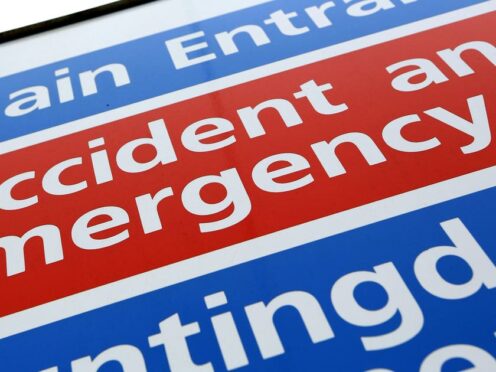
Cash incentives will be offered to hospitals that do not leave patients waiting in A&E for 12 hours or more under new plans by NHS England.
The health service will also increase its use of virtual wards in a bid to free up space in emergency departments.
Experts welcomed the measures – which form part of an update to the Urgent and Emergency Care Recovery Plan – but warned that they come at a time when the NHS is “in crisis”.
In a letter to trusts and integrated care boards (ICBs), NHS England hailed “marked year-on-year improvement in the headline ambitions set out in the plan”, which was first published in January 2023.
It also claimed last year was the first outside the pandemic since 2009 that more patients were treated in A&E within four hours when compared to the prior 12 months.
According to the updated plan, up to £150 million will be allocated to NHS operational capital budgets in 2025/26 to “incentivise both highest performance and greatest improvement in performance since 2023/24”.
For the first time, the targets include a reduction in 12-hour A&E wait times, along with an improvement in four-hour waits and an improved response to ambulance calls that are classed as an emergency.
The latest monthly figures from NHS England showed 42,078 people waited more than 12 hours in A&E departments in April from a decision to admit to actually being admitted, down slightly from 42,968 in March.
Some 74.4% of patients were seen within four hours last month, up from 74.2% in March and the highest figure since April 2023.
The NHS target for patients to be admitted, transferred or discharged within four hours is currently 76%.
This will rise to 78% by March 2025 as part of the latest update, although it remains below the 95% operational target set in 2010.
Dr Adrian Boyle, president of the Royal College of Emergency Medicine, welcomed the “continued emphasis” on improving emergency care and described long A&E waits as “dehumanising, degrading and dangerous”.
He added: “Reducing the time people spend in our emergency departments – especially for those patients who experience extreme waits because there are no in-patient beds for them – has to be the priority.”
Health minister Helen Whately said: “We’re learning from what worked to do better again this year, like helping people get home sooner when they are well enough to leave hospital and preventing people needing to go to hospital in the first place.
“We’re making our health service faster, fairer and simpler, and urgent and emergency care is at the forefront of that.”
Sarah-Jane Marsh, national director for urgent and emergency care at NHS England, hailed the “hard work of NHS staff” for what she described as a year of “considerable progress in the recovery of urgent and emergency care services”.
However, she said “there is still much further to go”.
Hospitals will be encouraged to refer more patients to virtual wards, which allow patients to remain at home while receiving care from clinical staff.
The National Institute for Health and Care Excellence (Nice) recommended their use for patients with acute respiratory infections last summer.
It was further expanded to include heart failure patients in October.
NHS England said it created 12,000 virtual beds as part of the Urgent and Emergency Care Recovery Plan, with 73% capacity taken up in March of this year.
Other measures included in the update are frailty assessments at the door of A&E for older patients who may need specialist care, and clinical assessments of 999 and 111 calls to ensure patients are directed to the best service for them.
More flexibility will also be offered to urgent and emergency care staff in a bid to retain and recruit workers.
Sir Julian Hartley, chief executive of NHS Providers, said trust leaders and their teams “are working hard” against “a backdrop of unprecedented pressure on ambulance services and emergency departments”.
“Driving down long waiting times for patients rightly remains a top priority for leaders across hospital, mental health, ambulance and community services and their health and care partners,” he added.
“It is right that the next phase of the urgent and emergency care recovery plan focuses on rolling out successful initiatives to help reduce waits, improve care and ensure patients are seen in the right place, at the right time, according to clinical need.”
Siva Anandaciva, chief analyst at The King’s Fund, said the update “contains many sensible proposals” and the “increased spotlight” on the longest A&E waits “should be welcomed”.
He added: “The efforts to deliver more care in the community through virtual wards has great potential to reduce avoidable admissions and help patients when stepping up or down from hospital care, as long as this approach also comes with investment in staff skills and infrastructure.
“Many people end up attending A&E after experiencing difficulties accessing GP appointments or other local avenues for care, exacerbating already high demand for urgent and emergency care.
“It is good to see national decision-makers and politicians make a strategic decision to bolster community services as part of their solution to free up overcrowded hospitals.”
However, Mr Anandaciva said the plan for “gradual improvements” comes at a time when the health service is “in crisis”.
“It has been nearly a decade since A&E performance targets were reliably met, and there is little prospect of performance substantially improving in the near future.
“It is patients and staff who are bearing the brunt of the sharp deterioration in NHS performance over the past 10 years.”

Enjoy the convenience of having The Sunday Post delivered as a digital ePaper straight to your smartphone, tablet or computer.
Subscribe for only £5.49 a month and enjoy all the benefits of the printed paper as a digital replica.
Subscribe